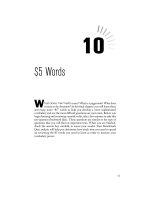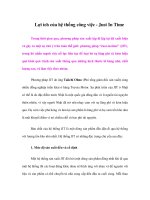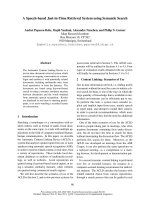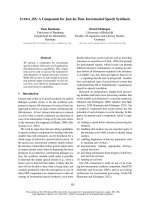Learning express Just In Time Vocabulary - Study Skills
Bạn đang xem bản rút gọn của tài liệu. Xem và tải ngay bản đầy đủ của tài liệu tại đây (102.01 KB, 15 trang )
I
f you have left studying for that big test until the last minute, you
may be feeling that your only option is to cram. You might be feeling
panicky that you will never have enough time to learn what you need to
know. But the “Just in Time” solution is exactly that: “just in time.’’ This
means that with the help of this book you can use your available time prior
to your test effectively. First, to get ready for your test just in time, you
need a plan. This chapter will help you put together a study plan that max-
imizes your time and tailors your learning strategy to your needs and goals.
There are four main factors that you need to consider when creating
your study plan: what to study, where to study, when to study, and how
to study. When you put these four factors together, you can create a spe-
cific plan that will allow you to accomplish more—in less time. If you have
three weeks, two weeks, or even one week to get ready, you can create a
plan that avoids anxiety-inducing cramming and focuses on real learning
by following the simple steps in this chapter.
WHAT TO STUDY
Finding out what you need to study for your test is the first step in cre-
ating an effective study plan. You need to have a good measure of your
Study Skills
1
1
JUST IN TIME VOCABULARY
2
ability in vocabulary. You can accomplish this by looking over the Table of
Contents to see what looks familiar to you and by answering the Benchmark
Quiz questions starting in the next chapter. You also need to know exactly
what is covered on the test you will be taking. Considering both your abil-
ity and the test content will tell you what you need to study.
◗
Establish a Benchmark
In each chapter you will take a short, ten-question Benchmark Quiz that
will help you assess your skills. This may be one of the most important steps
in creating your study plan. Because you have limited time, you need to be
very efficient in your studies. Once you take a chapter Benchmark Quiz and
analyze the results, you will be able to avoid studying the material you
already know. This will allow you to focus on those areas that need the most
attention.
A Benchmark Quiz is only practice. If you did not do as well as you antic-
ipated you might, do not be alarmed and certainly do not despair. The pur-
pose of the quiz is to help you focus your efforts so that you can improve. It
is important to carefully analyze your results. Look beyond your score, and
consider why you answered some questions incorrectly. Some questions to
ask yourself when you review your wrong answers:
• Did you get the question wrong because the vocabulary word was
totally unfamiliar?
• Was the vocabulary familiar but were you unable to come up with
the right answer due to the question context? In this case, when you
read the right answer it will often make perfect sense. You might
even think, “I knew that!”
• Did you answer incorrectly because you read the question care-
lessly?
• Did you make another careless mistake? For example, circling
choice a when you meant to circle choice b.
Next, look at the questions you got correct and review how you came up
with the right answer. Not all right answers are created equally.
• Did you simply know the right answer?
• Did you make an educated guess? An educated guess might indicate
that you have some familiarity with the word, but you probably
need at least a quick review of the definition.
• Or did you make a lucky guess? A lucky guess means that you don’t
know the word and you will need to learn it.
STUDY SKILLS
3
Your performance on the Benchmark Quiz will tell you several impor-
tant things. First, it will tell you how much you need to study. For exam-
ple, if you got eight out of ten questions right (not counting lucky guesses),
you might only need to brush up on certain vocabulary words. But if you
got five out of ten questions wrong, you will need a thorough review of the
chapter. Second, it can tell you what you know well, that is which subjects
you don’t need to study. Third, you will determine which category of words
you need to study in-depth, and which words you simply need to refresh
your knowledge of.
◗
Targeting Your Test
For the “Just in Time” test-taker, it is important to focus your study efforts
to match what is needed for your test. You don’t want to waste your time
learning something that will not be covered on your test. There are three
important aspects that you should know about your test before developing
your study plan:
• What material is covered?
• What is the format of the test? Is it multiple choice? Fill in the
blank? Some combination? Or something else?
• What is the level of difficulty?
How can you learn about the test before you take it? For most stan-
dardized tests, there are sample tests available. These tests—which have
been created to match the test that you will take—are probably the best way
to learn what will be covered. If your test is non-standardized, you should
ask your instructor specific questions about the upcoming test.
You should also know how your score will affect your goal. For example,
if you are taking the SAT exam, and the median verbal score of students
accepted at your college of choice is 550, then you should set your sights on
achieving a score of 550 or better. Or, if you are taking the New York City
Police Officer exam, you know that you need to get a perfect or near-perfect
score to get a top slot on the list. Conversely, some exams are pass or fail. In
this case, you can focus your efforts simply on achieving a passing score.
◗
Matching Your Abilities to Your Test
Now that you understand your strengths and weaknesses and you know
what to expect of your test, you need to consider both factors to determine
what material you need to study. First, look at the subject area or question
type with which you have the most trouble. If you can expect to find ques-
tions of this type on your test, then this subject might be your first priority.
JUST IN TIME VOCABULARY
4
But be sure to consider how much of the test, will cover this material. For
example, if there will only be a few questions out of a hundred that test your
knowledge of a subject that is your weakest area, you might decide not to
study this subject area at all. You might be better served by concentrating
on solidifying your grasp of the main material covered on the exam.
The important thing to remember is that you want to maximize your
time. You don’t want to study material that you already know, and you don’t
want to study material that you don’t need to know. You will make the best
use of your time if you study the material that you know the least, but that
you most need to know.
WHERE TO STUDY
The environment in which you choose to study can have a dramatic impact
on how successful your studying is. If you chose to study in a noisy coffee
shop at a small table with dim lighting, it may take you two hours to cover
the same material you could read in an hour in the quiet of the library. That
is an hour that you don’t have to lose! However, for some people the noisy
coffee shop is the ideal environment. You need to determine what type of
study environment works for you.
◗
Consider Your Options
Your goal is to find a comfortable, secure place that is free from distractions.
The place should also be convenient and conform to your schedule. For
example, the library might be ideal in many respects. However, if it takes
you an hour to get there and it closes soon after you arrive you are not max-
imizing your study time.
For many people studying at home is a good solution. Home is always
open and you don’t waste any time getting there, but it can have drawbacks.
If you are trying to fit studying in between family obligations, you might
find that working from home offers too many opportunities for distraction.
Chores that have piled up, children or younger siblings who need your
attention, or television that captures your interest, are just some of things
that might interfere with studying at home. Or maybe you have roommates
who will draw your attention away from your studies. Studying at home is
a good solution if you have a room that you can work in alone and away
from any distractions.
If home is not a good environment for quiet study, the library, a reading
room, or a coffee shop are places you can consider. Be sure to pick a place
that is relatively quiet and which provides enough workspace for your needs.
STUDY SKILLS
5
◗
Noise
Everyone has his or her own tolerance for noise. Some people need
absolute silence to concentrate, while others will be distracted without some
sort of background noise. Classical music can be soothing and might help
you relax as you study. If you think you work better with music or the tel-
evision on, you should be sure that you are not paying attention to what’s
on in the background. Try reading a chapter or doing some problems in
silence, then try the same amount of work with noise. Which noise level
allowed you to work the fastest?
◗
Light
You will need to have enough light to read comfortably. Light that is too
dim will strain your eyes and make you drowsy. Too bright and you will be
uncomfortable and tense. Experts suggest that the best light for reading
comes from behind and falls over your shoulder. Make sure your light
source falls on your book and does not shine in your eyes.
◗
Comfort
Your study place should be comfortable and conducive to work. While your
bed might be comfortable, studying in bed is probably more conducive to
sleep than concentrated learning. You will need a comfortable chair that
offers good back support and a work surface—a desk or table—that gives
you enough space for your books and other supplies. Ideally, the tempera-
ture should be a happy medium between too warm and too cold. A stuffy
room will make you sleepy and a cold room is simply uncomfortable. If you
are studying outside your home, you may not be able to control the tem-
perature, but you can dress appropriately. For example, bring along an extra
sweater if your local library is skimpy with the heat.
◗
A Little Help
When you have settled on a place to study, you will need to enlist the help
of your family and friends—especially if you are working at home. Be sure
they know that when you go to your room and close the door to study, you
do want to be disturbed. If your friends all go to the same coffee shop
where you plan to study, you will also need to ask them to respect your
study place. The cooperation of your family and friends will eliminate one
of the greatest potential distractions.
JUST IN TIME VOCABULARY
6
WHEN TO STUDY
Finding the time in your busy schedule may seem like the greatest hurdle
in making your “just in time” study plan, but you probably have more time
available than you think. It just takes a little planing and some creativity.
◗
Analyze Your Schedule
Your first step in finding time to study is to map out your day-to-day sched-
ule—in detail. Mark a piece of paper in fifteen-minute intervals from the
time you get up to the time you generally go to bed. Fill in each fifteen-
minute interval. For example, if you work from nine to five, do not simply
block that time off as unavailable for study. Write down your daily routine
at work and see when you might have some time to study. Lunch is an obvi-
ous time. But there may be other downtime in your workday when you can
squeeze in a short study session.
You will want to set aside a stretch of time when you plan to study in your
designated study place. But you can also be creative and find ways to study
for short bursts during your normal routine. For example, if you spend an
hour at the gym on the stationary bike, you can read while you cycle. Or
you can review flashcards on your bus ride. If you drive to work, you could
record some study material on a tape or CD. You could also listen to this
tape while you walk the dog.
When you look at your schedule closely, you will probably find you have
more time than you thought. However, if you still don’t have the time you
need, you should rethink your routine. Can you ask your significant other
to take on a greater share of the household chores for the few weeks you
need to get ready for your test? Is there some activity that you can forgo for
the next few weeks? If you normally go to the gym six days a week for an
hour and a half, cut down to three days a week for forty-five minutes. You
will add over six and a half hours to your schedule without completely aban-
doning your fitness routine. Remember any changes you make to your
schedule are short-term and a small sacrifice, once you consider your goal.
◗
Time Strategies
Now that you know when you have time available you need to use that time
to the best advantage. You will probably find that you can set aside one
block of time during the day during which you will do the bulk of your
studying. Use this time to learn new material or take a practice quiz and
review your answers. Use the small spurts of time you have found in your
schedule to review with flashcards, cheat sheets, and other tools.
Also consider your learning style and body rhythm when you make your









